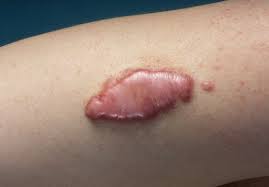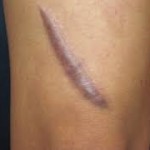A hypertrophic scar is characterized by a red, raised fibrous lesion that does not expand beyond the boundaries of the initial injury. Interestingly, they can undergo partial spontaneous resolution and are more common after a thermal injury (burn) or other injuries that involved the deep dermis. The highest incidence of individuals who suffer from keloid or hypertrophic scars are between the ages of 10 and 20 years.

In some cases, where the original injury is located at a joint, some keloids or hypertrophic scars can cause contractures. This can result in the loss of function or significant disfigurement if the scar is located on the face. Keloid scarring will occur more frequently in individuals who are of Asian descent and as many as 16% of random sampling of black Africans report having keloids.
Individuals who suffer from burns often wear pressure dressings for months to several years after the original injury. This is a method of preventing hypertrophic or keloid scarring. Keloid scars can possibly be prevented by using pressure dressings, silicone gel pads or paper tape over the injury site when worn for 23 of 24 hours each day. The treatment for a keloid scar is usually started within the first month after the wound has healed and continues for several months afterwards. This is especially important in individuals who know they are prone to developing scarring.
Once keloid scars have formed there is no completely satisfactory treatment. Dermatologists will try freezing or cryosurgery, excision, laser, x-rays and steroid injection. The best initial treatment appears to be steroid injections into the keloid once a month. This usually makes these scars less noticeable and flattened within three to six months time. Hypertrophic scars often respond completely but keloids are much more difficult to treat.
In severe cases keloid scars can be surgically excised and given x-ray treatment to the site immediately afterwards. There has been an 85% rate of success reported in the most severe cases. Up until this time there have not been any reports of this particular treatment causing any form of cancer but the treatment is very expensive and not always covered by insurance. (1)
References:
(1) American Osteopathic College of Dermatology: Keloids and Hypertrophic Scars
http://www.aocd.org/skin/dermatologic_diseases/keloids_and_hypert.html
| Advertisement | |
|
|
Reduce the appearance of unsightly scars from:
|



Leave a Reply